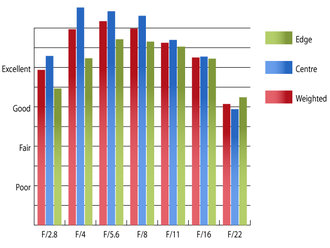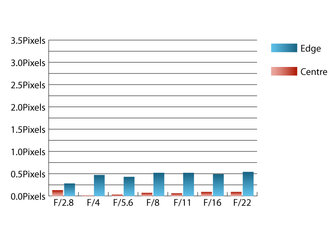Canon EF 24mm f/2.8 IS USM Lens Review
Canon EF 24mm f/2.8 IS USM Performance
As far as sharpness is concerned, this lens delivers excellent performance, even at f/2.8. At maximum aperture, sharpness in the centre of the frame is already excellent, and the clarity towards the edges of the frame is very good. Stopping down improves sharpness further with the centre being outstanding between f/4 and f/11 and the edges reaching similar levels of clarity between f/5.6 and f/11. | How to read our chartsThe blue column represents readings from the centre of the picture frame at the various apertures and the green is from the edges. Averaging them out gives the red weighted column.The scale on the left side is an indication of actual image resolution. The taller the column, the better the lens performance. Simple. For this review, the lens was tested on a Canon EOS 5D MkII using Imatest. |
Chromatic aberrations are well controlled, only just exceeding half a pixel width towards the edges of the frame with the lens stopped down to f/22. This low level of fringing should pose few issues, even in large prints, or harsh crops from the edges of the frame.
 | How to read our chartsChromatic aberration is the lens' inability to focus on the sensor or film all colours of visible light at the same point. Severe chromatic aberration gives a noticeable fringing or a halo effect around sharp edges within the picture. It can be cured in software.Apochromatic lenses have special lens elements (aspheric, extra-low dispersion etc) to minimize the problem, hence they usually cost more. For this review, the lens was tested on a Canon EOS 5D MkII using Imatest. |
Falloff of illumination towards the corners of the frame is very strong at maximum aperture. At f/2.8 the corners are 3.81 stops darker than the image centre and visually uniform illumination is achieved until the aperture is stopped down to f/8 or beyond.
Only a mild level of 1.22% barrel distortion is present and the distortion pattern is uniform across the frame, which should make it relatively straightforward to correct in image editing software afterwards.
No lens hood is supplied as standard by Canon, which is a shame. Bright light sources in the frame can cause flare, and loss of contrast, so it would've been good of Canon to include a hood to help reduce this. An EW-65B lens hood will set you back an eye-watering £47. For that price you'd be forgiven for expecting it to be made from carbon fibre, or titanium... it's not.
Add your message
Login required
Please login here or if you've not registered, you can register here. Registering is safe, quick and free.
Please login here or if you've not registered, you can register here. Registering is safe, quick and free.
photodo Stats
1102 lenses
428 MTF tests
74 in-depth photodo reviews
100+ users join each day
Help the lens community by reviewing or rating a lens today via our lens search
428 MTF tests
74 in-depth photodo reviews
100+ users join each day
Help the lens community by reviewing or rating a lens today via our lens search
Latest Lens Reviews
- Chinon 28mm f/2.8 Vintage Lens Review
- Canon EF 70-200mm f/4L IS II USM Lens Review
- Samyang AF 85mm f/1.4 EF Review
- Sigma 70mm f/2.8 DG Macro Art Review
- Samyang AF 24mm f/2.8 FE Review
- Meike 50mm f/1.7 Review
- Tamron 70-210mm f/4 Di VC USD Review
- Lensbaby Burnside 35mm f/2.8 Review
- Asahi Super Takumar 50mm f/1.4 Review
- Asahi Super-Multi-Coated Takumar 135mm f/3.5 Review
